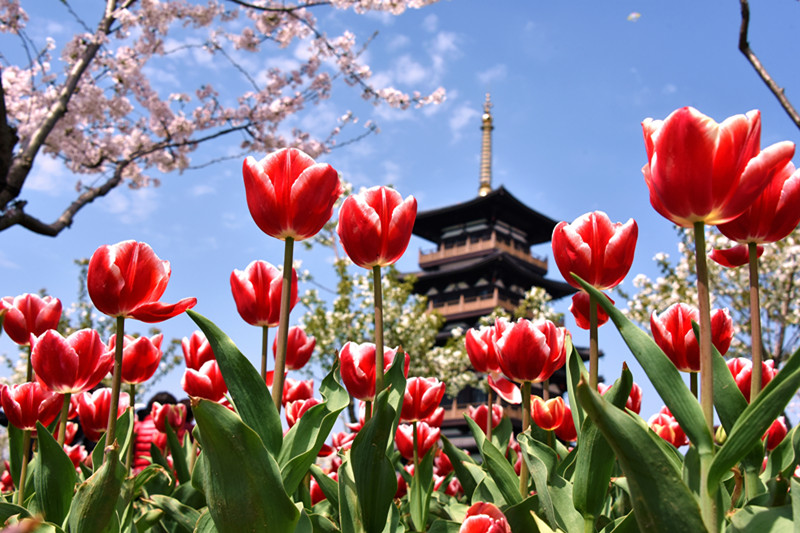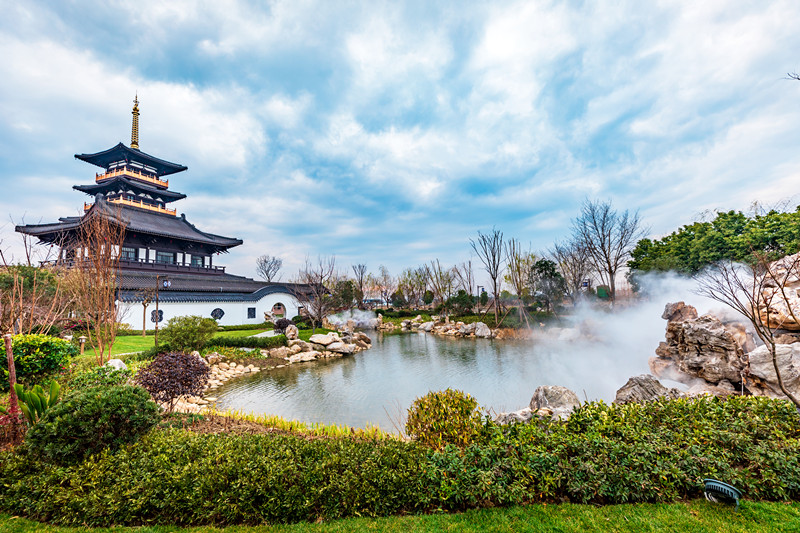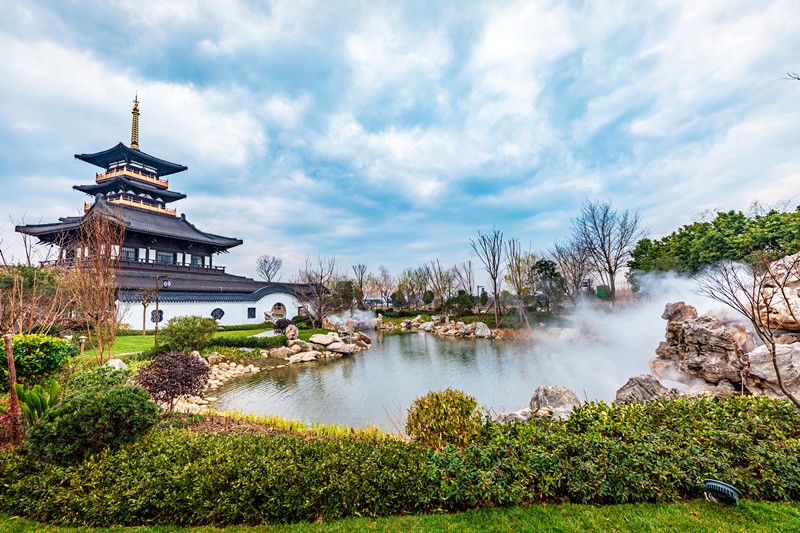The Sakura Park covers an area of about 850 mu(about 57 hectares)including Sakura Forest, Sakura Island and Sakura Square. The "EightSakura Sceneries" are scattered in the area forming a really beautiful scenery. The pavilions built in the Sakura Square in Tang construction style, a good matching to the bright sakura, so as to reflect the flourishing Tang Dynasty scene.

As early as the Qin and Han Dynasties, the sakura had been planted often in the royal palaces. By the Tang Dynasty, the sakura were widely seen in private courtyards. The Pilgrims coming from Japan took the sakura back and planted them in large quantities They were honored as the national flower of Japan ever since. More than 20,000 sakura trees are planted in Sakura Town, restoring the magnificent scenery of sakura in the flourishing Tang Dynasty.

Sakura Forest
In the Sakura Forest in front of the Sakura Square, there are 150,000 varieties of tulips and hyacinths. The tulip is a perennial herbaceous plant of Liliaceae. It has various varieties in different gorgeous and graceful colors.. Every year during the blooming period of March and April,the tulip and sakura will bloom together, adding radiance and beauty to each other.


Changfeng Tower has seven floors, 33 meters high. It is the landmark building of Sakura Town as well as a new cultural landmark of Zhongdai Town and even Pinghu City. The name "Changfeng Tower" comes from the poem written in Tang Dynasty: "Winds and waves will be there sometimes, while I will be with my sail between the clouds and the sea". There are stairs inside the tower, which will lead you to the top for a bird view to the Sakura Town.
The first to the fourth floor of the tower restore the history and culture of Zhongdai Street through modern technologies such as acoustics and optoelectronics, including its delicacies, non-material cultural heritage, historical related stories, etc. It is a special experience that will never let you forget.

Changfeng Tower

Linying Attic is situated at the left side of Changfeng Tower and the west side of Qixin corridor. It is a two-floor overhanging eaves attic. The name of "Linying" means to climb to the top of the attic to have a bird view of Sakura Park, just like flying over the sakura clouds.
The first floor is set as sakura science museum with rich pictures and articles and various methods to display the science knowledge and stories about sakura, so as to make people to better know about it. The second floor is set as a multi-functional hall for various exhibitions, which can also be used for holding banquets.

Linying Attic

Yingmeng Pavilion , located in the eastern section of Qixin Corridor, is a two-layered quadrangle square pavilion with four corners. In front of the pavilion, the courtyard is surrounded by the wingding corridor. It is named as "Yingmeng Pavillion" to imply the dream of seeking the buauty of sakura.

Yingmeng Pavilion
Qixin Corridor, located in the Sakura Square, is 218 meters long in the direction of east and west, 2.1 meters wide in east and 2.7 meters wide in west. It is a classical winding garden corridor surrounded by Yingmeng Pavilion and Jicui Pavilion, changing scenery and endless spring.

Qixin Corridor
Jicui Pavilion is situated at the center of the Qixin Corridor, a two-layered octagonal pavilion, in front of which is the Sakura Square. Its name "Jicui Pavillion" implies a collection of best sakura variety.

Jicui Pavilion
Xiao Tongtian, which covers an area of 5 mu(about 0.3 hectares), is located behind Linying Attic near Jiashan Pool. It is a small garden building with Jiangnan characteristics. On the door there is a couplet that says “Leaning against the railing, watching the moon shine through the door, listening to the sound of rain beating on the windows; Climb high and look far, see the morning mist, see the sunset ". The artistic conception of this couplet is from Huang Gongwang's inscription in his paintings in his 80s. He called his hermit place as "Xiao Dongtian", which displays the traditional arrangement for the building, with a sense of hidden beauty atmosphere.

Xiao Tongtian



